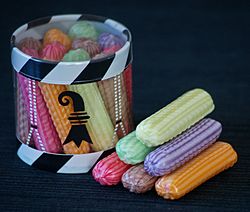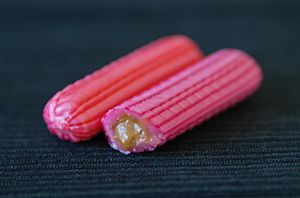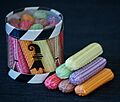Mässmogge facts for kids
 |
|
| Type | Sugar candy |
|---|---|
| Place of origin | Switzerland |
| Region or state | Basel |
| Main ingredients | Hazelnuts |
| Variations | Glasmogge |
Mässmogge are special candies from Basel, Switzerland. They are about the size of your thumb and are filled with a tasty hazelnut praline. These sweet treats are a local favorite, especially during the autumn fair in Basel.
Contents
What's in a Name?
The name "Mässmogge" comes from the local dialect spoken in Basel, called Basel German.
- "Mäss-" means "fair" (like a big market or festival). This is because the candy is mostly sold at the famous Basel autumn fair.
- "Mogge" comes from an old German word, Mocken, which means "a big piece" or "lump."
So, "Mässmogge" basically means "fair lump" or "fair candy piece."
What Are Mässmogge Like?
Mässmogge candies are usually about 5.5 centimeters (2 inches) long and 2 centimeters (0.8 inches) wide. Each one weighs about 14 grams (0.5 ounces).
They have two main parts:
- The Shell: This is a colorful, striped outer layer made of soft sugar candy. It comes in different flavors like chocolate, lemon, or strawberry. The color of the candy usually tells you its flavor!
- The Filling: Inside, you'll find a soft, creamy hazelnut praline. This filling has a stronger, richer flavor than the outer shell.
Glasmogge: A Special Kind of Mässmogge
There's also a simpler version called Glasmogge, which means "lump of glass." These candies don't have the hazelnut filling. They are just a piece of sugar candy, usually green and flavored with peppermint.
How Many Are Made?
A lot of Mässmogge are made each year! Around one million candies are produced annually. About 70% of these are the hazelnut-filled kind. Most Mässmogge are sold at the Basel autumn fair. The rest are sold in shops around Basel and the nearby region of Solothurn.
How Are Mässmogge Made?
Making Mässmogge is a tricky process, and much of it is still done by hand!
- Making the Candy Mass: First, sugar, glucose, and water are heated to a very high temperature (134 degrees Celsius or 273 degrees Fahrenheit). This mixture is then stirred to make it airy and white.
- Adding Color and Layers: Next, colors are added, and the candy is folded into a striped, layered paste.
- Adding the Filling: A special hazelnut filling is prepared from roasted and ground hazelnuts, mixed with some fat and sugar. This filling is then spread over the candy mass.
- Shaping the Candies: The whole candy mixture is rolled into a huge piece, weighing about 50 kilograms (110 pounds). A machine then stretches this roll out to an amazing length of about 2.5 kilometers (1.5 miles)! Finally, it's cut into individual Mässmogge candies.
The entire process, from heating the sugar to cutting the candies, must be done very quickly, in less than 25 minutes. This keeps the candy warm and soft enough to work with.
The History of Mässmogge
Candy canes first appeared at Basel fairs in the 1860s, brought by French candy makers. By 1879, these candies were sold as thick lumps.
The Mässmogge we know today, with its delicious hazelnut filling, was invented around 1900. A candy maker named Leonz Goldinger created this special treat. Back then, the candies were made right at the fair and sold while they were still warm!
For many years, several candy makers produced Mässmogge for the Basel fairs. However, making these candies is quite expensive. Today, only one company, Sweet Basel AG, continues to make Mässmogge.
Images for kids




